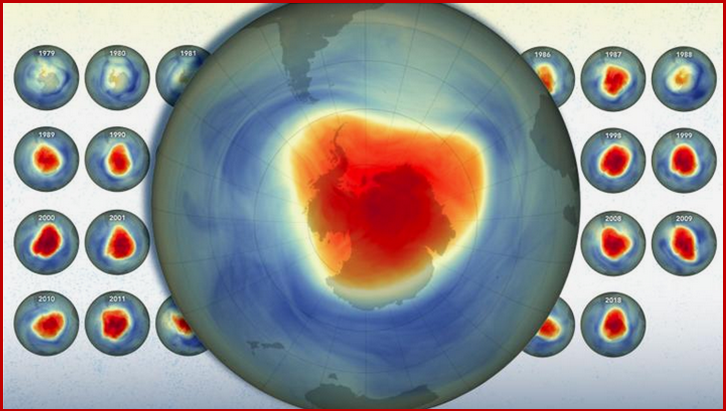Click to enlarge.
Anthropogenic or Human Caused Healing
In their new study, the MIT team took a quantitative approach to identify the cause of Antarctic ozone recovery. The researchers borrowed a method from the climate change community, known as “fingerprinting,” which was pioneered by Klaus Hasselmann, who was awarded the Nobel Prize in Physics in 2021 for the technique. In the context of climate, fingerprinting refers to a method that isolates the influence of specific climate factors, apart from natural, meteorological noise. Hasselmann applied fingerprinting to identify, confirm, and quantify the anthropogenic fingerprint of climate change.
Solomon and Wang looked to apply the fingerprinting method to identify another anthropogenic signal: the effect of human reductions in ozone-depleting substances on the recovery of the ozone hole.
“The atmosphere has really chaotic variability within it,” Solomon said. “What we’re trying to detect is the emerging signal of ozone recovery against that kind of variability, which also occurs in the stratosphere.”
The researchers started with simulations of the Earth’s atmosphere and generated multiple “parallel worlds,” or simulations of the same global atmosphere, under different starting conditions. For instance, they ran simulations under conditions that assumed no increase in greenhouse gases or ozone-depleting substances. Under these conditions, any changes in ozone should be the result of natural weather variability. They also ran simulations with only increasing greenhouse gases, as well as only decreasing ozone-depleting substances.
They compared these simulations to observe how ozone in the Antarctic stratosphere changed, both with season, and across different altitudes, in response to different starting conditions. From these simulations, they mapped out the times and altitudes where ozone recovered from month to month, over several decades, and identified a key “fingerprint,” or pattern, of ozone recovery that was specifically due to conditions of declining ozone-depleting substances.
The team then looked for this fingerprint in actual satellite observations of the Antarctic ozone hole from 2005 to the present day. They found that, over time, the fingerprint that they identified in simulations became clearer and clearer in observations. In 2018, the fingerprint was at its strongest, and the team could say with 95% confidence that ozone recovery was due mainly to reductions in ozone-depleting substances.
“After 15 years of observational records, we see this signal to noise with 95 % confidence, suggesting there’s only a very small chance that the observed pattern similarity can be explained by variability noise,” Wang said. “This gives us confidence in the fingerprint. It also gives us confidence that we can solve environmental problems. What we can learn from ozone studies is how different countries can swiftly follow these treaties to decrease emissions.”
If the trend continues, and the fingerprint of ozone recovery grows stronger, Solomon anticipates that soon there will be a year, here and there, when the ozone layer stays entirely intact. And eventually, the ozone hole should stay shut for good.


